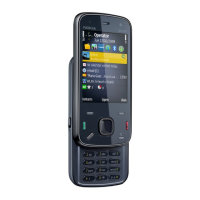Required equipment
The following equipment is needed for the tests:
•
Oscilloscope
•
Function generator (sine waveform)
•
Current probe (Internal handsfree DPMA output measurement)
•
Phoenix service software
•
Battery voltage 3.7V
•
Sound source (laptop speaker or B&K type 4231 calibrator)
Test procedure
Audio can be tested using the Phoenix audio routings option. Three different audio loop paths can be
activated:
•
External microphone to Internal earpiece
•
External microphone to Internal handsfree speaker
•
Internal microphone to External earpiece
Each audio loop sets routing from the specified input to the specified output enabling a quick in-out test.
Loop path gains are fixed and they cannot be changed using Phoenix. Correct pins and signals for each test
are presented in the following table.
Phoenix audio loop tests and test results
The results presented in the table apply when no accessory is connected and battery voltage is set to 3.7V.
Earpiece, internal microphone and speaker are in place during measurement. Applying a headset accessory
during measurement causes a significant drop in measured quantities.
The gain values presented in the table apply for a differential output vs. single-ended/differential input.
Loop test Input
terminal
Output
terminal
Path gain
[dB]
(fixed)
Input
voltage
[mVp-p]
Outout
voltage
[mVp-p]
Output DC
level [V]
Output
current
[mA]
External
Mic to
External
Earpiece
HS_MIC &
GND
HS_EAR_L
& GND
-8.6 1000 367 1.2 NA
HS_EAR_R
& GND
External
Mic to
Internal
Earpiece
HS_MIC &
GND
EarP & -10 1000 310 1.2 NA
GND
EarN &
GND
External
Mic to
Internal
handsfre
e
HS_MIC &
GND
J2103 &
J2104
-6 1000
J2101 &
J2102
RM-484; RM-485; RM-486
BB Troubleshooting
Page 3 –40 COMPANY CONFIDENTIAL Issue 1
Copyright © 2009 Nokia. All rights reserved.

